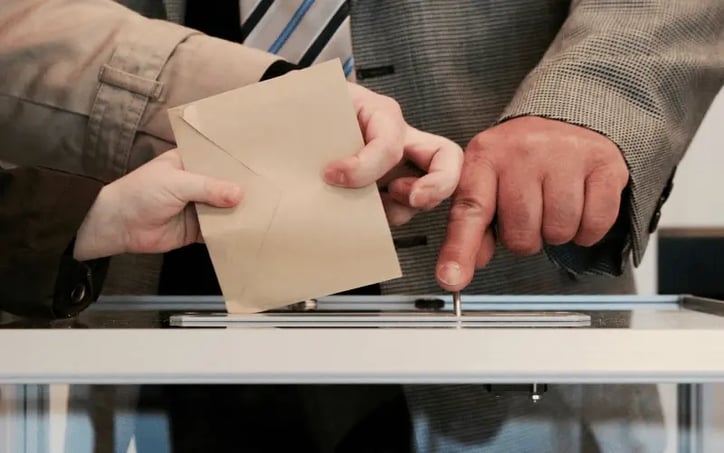Elections, more so than other events covered in the news cycle, have readers craving real-time information, results, and updates. Leading up to election day, background analyses evaluate potential outcomes and present the candidates and their positions in detail. As soon as the polling stations close, voters clamour for the first projections. However, despite their interest, few people follow the event continuously on television. With hours, sometimes even days, passing between the polling stations' opening and the final results' announcements, publishers need to ensure that they are nurturing their audiences with a steady flow of information in a way that consumers can easily access throughout their day.
Live blogs do just this by keeping readers up to date and allowing them to catch up on developments later.

Photo by Arnaud Jaegers on Unsplash
In this article, we look at the advantages of using liveblogs when covering elections and highlight what you should keep in mind when creating them for the first time. Using examples, we share how large media houses, regional newspapers, and smaller communities can use liveblogs during local elections.
THE ADVANTAGES OF LIVEBLOGGING ELECTIONS
Liveblogs offer numerous advantages for media companies and communities that want to use them to disseminate information during election season. These advantages include the following:
-
⏰ Timely Updates: Readers are informed about what is happening in real time and don't miss any important events.
- 📱 Flexibility: Liveblogs can be updated anytime. This means readers don't have to wait for the next issue or broadcast to get the latest information.
- 👩💻 Detailed Record Keeping: Exact event developments can be reviewed at a later date.
- 🌍 Availability: Liveblogs can be accessed by readers worldwide and at any time. Thanks to responsivity, the output medium does not matter either.
- 🗣️ Interactivity: Readers can actively engage with the story via liveblog with integrated comments, quizzes, or polls.
INTEGRATE EXTERNAL CONTENT FOR SIMPLIFIED VERIFIED REPORTING
Another advantage for many editorial teams is that they do not have to create all the content themselves. News agencies such as the dpa offer their own liveblogs for many elections. Its content can be purchased and integrated into the editorial team's own liveblog.
These agency posts, created according to the highest journalistic standards, already lay the foundation for the liveblog. By adding their own posts, analyses, and comments, the local editorial teams can then meet the content and information needs of their own readership.
WHAT TO LOOK FOR WHEN CREATING AN ELECTION LIVEBLOG FOR THE FIRST TIME
When covering elections, one thing is clear: whether you are covering a local or federal election - sensitivity, accuracy, and tact are required. Readers demand accurate reporting held to the highest journalistic standards. Therefore, it's essential that the following tasks are taken seriously when creating a liveblog on political elections:
- 🛠️ Selecting a quality tool for creating the liveblog (e.g., Tickaroo's liveblog software) - With high traffic spikes, it's important that you select a software that can handle your audiences' reading behaviour.
- 📝 Creating a clear structure and using understandable language - Readers need to be able to easily find the information they are searching for.
- 📹 Using visual and video material to illustrate the events - Visuals not only catch readers attention, but they also enable readers to get a fuller picture of events, and keeps readers engaged with your story for longer.
- 📊 Providing source citations and background information on candidates and parties. Readers are coming to you for verified information. Be sure to provide them with what they are looking for.
- 🙋 Interacting with readers (e.g. comment function or voting) - Providing your readers with information is no longer enough. They want to be a part of the story, too. Numerous interactive mediums can be integrated into liveblogs from polls to live comments.
EXAMPLES OF LIVEBLOGS IN POLITICAL ELECTION COVERAGE
Examples of successful political election liveblogs abound.
Even in Germany, this election took over the news cycle for numerous days. Publishers from across Germany wrote a variety of liveblogs covering the close election taking place across the Atlantic. Many news providers embedded verified posts from the German Press Agency (dpa), while also sharing numerous regionally significant data and stories within the same liveblog to make their coverage highly relevant to their readers.
One example is "Zeit Online's" liveblog on the 2022 state election in Schleswig-Holstein, which was updated regularly and provided a wealth of information and analysis. In addition to images, graphics, and quotes, the editorial team also used embedded Twitter posts.
The liveblogs on "FiveThirtyEight", a website created by American journalist Nate Silver, regularly attract international attention. With an incredible wealth of detail, various authors analyze U.S. elections, using liveblogs for visual evaluations, detailed analyses and background reports.
One example of how liveblogs are also great for covering smaller elections is the "Märkische Allgemeine's" coverage on regional mayoral elections. The MAZ integrates various snapshots and short quotes, and focuses primarily on local events. In this way, readers are directly informed about the current standings in real time. The information is not limited to the overall election results, but also provides data on voter turnout and candidates.
